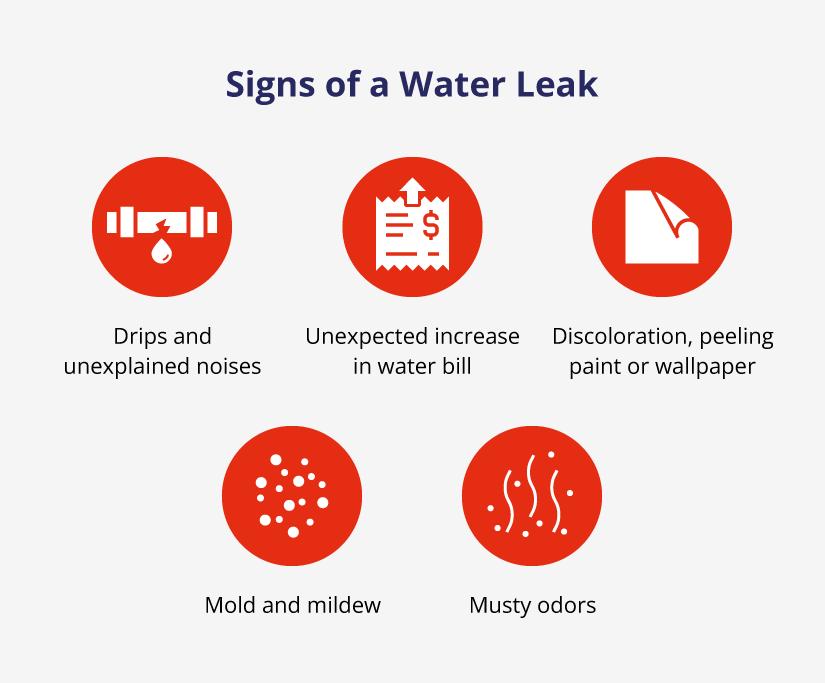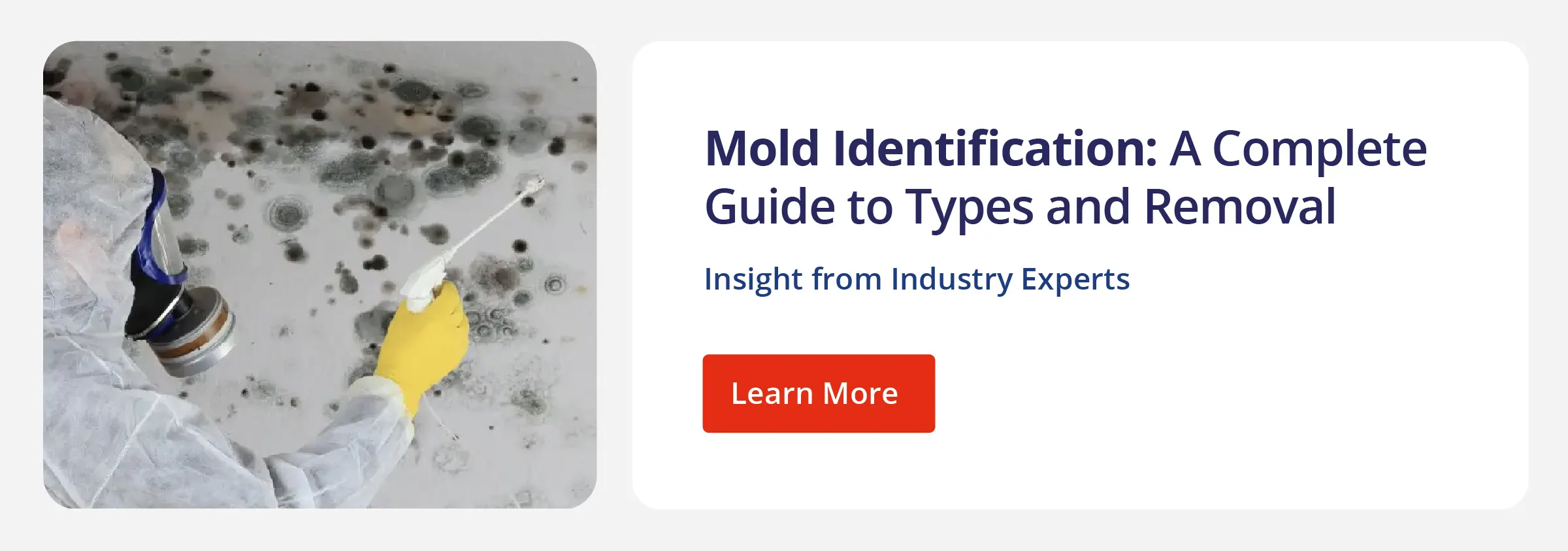.webp)
Discovering a water leak in your wall early can prevent costly damage. Rainbow Restoration outlines key steps to identify hidden leaks:
|
Sometimes water damage can occur without you even knowing it. And because water damage isn’t always obvious, it can cause considerable damage before it is detected. A slow leak may lurk inside the walls of your home before any damage is visible. So how do you fix a problem you can’t see?
Learn how to determine if water is leaking behind the walls and what you can do to fix it and mitigate the damage.
Table of Contents:
Step 1. Inspect Visually
The first step in this process is a thorough visual inspection. This initial assessment involves closely examining various aspects of the walls and ceilings for signs of water damage or leakage.
Check for the following to spot a water leak:
- Discoloration: Look for any unusual, difficult-to-remove stains or marks on the walls or ceilings, as these can indicate a slow, persistent leak.
- Peeling paint or wallpaper: Water leakage often causes paint or wallpaper to peel, bubble, or warp.
- Mold and mildew: Visible mold or mildew growth, often appearing as black, green, or white patches, suggests prolonged exposure to moisture.
- Warped or buckled walls and ceilings: Warping or buckling of the surface can be a result of water damage.
Step 2. Check Adjacent Areas
The next step in finding a water leak inside a wall involves carefully inspecting adjacent areas. The aim here is to trace the path of the water from any visible signs of leakage back to its source.
This could involve examining nearby rooms, floors, and ceilings. Checking these areas helps identify if the leak is localized or part of a larger problem, such as a plumbing issue affecting multiple areas.
To effectively check adjacent areas, consider the following:
- Inspect adjacent rooms: Examine the walls, floors, and ceilings of rooms next to and below the affected area.
- Look at plumbing fixtures: Check nearby plumbing fixtures like faucets, showerheads, and pipes for any signs of leakage or condensation.
- Use a stethoscope: Listen for the sound of dripping or running water within walls, which is often not audible to the naked ear.
- Check under sinks and cabinets: Inspect the areas under sinks and inside cabinets for any signs of moisture or water damage.
- Examine the flooring: Look for warping, discoloration, or dampness in the flooring, especially in areas like bathrooms and kitchens where plumbing is prevalent.
- Check exterior walls: Sometimes, water leaks can originate from the outside, so inspect the exterior walls for any cracks, damage, or signs of water intrusion from rain and floods.
Step 3. Touch the Area
Identifying a water leak inside a wall can even be done using physical touch. This tactile method can detect subtle differences in wall temperature and moisture levels.
Since water conducts heat differently than building materials, areas with leaks often feel cooler to the touch. This step is especially important after visually identifying potential problem areas, as it can help you identify exactly where the moisture is accumulating.
Focus on these areas:
- Discolored walls: Feel the surface of walls that show signs of discoloration or staining, as these are likely spots for moisture accumulation.
- Ceilings with water stains: Gently press against ceilings that have visible water stains to assess dampness.
- Near plumbing fixtures: Walls close to pipes, faucets, and showerheads are common sites for leaks — feel them for any irregularities.
- Basement walls: In basements, where dampness can be an issue from flooding and more, feeling the walls can help differentiate between general humidity and specific leak-related moisture.
- Exterior walls after rain: After rainfall, check walls from the inside to detect any areas that feel unusually cool or damp, indicating potential water ingress.
Step 4. Listen Carefully
If you suspect there is a leak inside your wall, listening carefully can be an effective way to locate a leak, as water makes distinct sounds as it moves through materials or drips from one surface to another. This step requires a quiet environment and a focused effort to detect subtle noises that could indicate the presence of water.
Different sounds can suggest different types of leaks, such as a steady drip versus a constant flow. Listening for water movement that isn't immediately visible can provide valuable clues in tracing the source of the leak.
When listening for water leaks, pay attention to these specific sounds:
- Dripping sounds: A rhythmic, intermittent sound usually indicates a slow, steady leak, often from a fixture or pipe.
- Hissing sounds: This can suggest a pressurized water line leak, where water is escaping from a small opening under pressure.
- Running water sounds: A continuous sound of water flowing could indicate a more substantial leak or a break in a pipe.
- Gurgling sounds: This noise may occur if water drains or air enters the plumbing system, potentially pointing to a blockage or break in the pipes.
- Splashing or trickling sounds: These sounds can be heard when water accumulates and moves in an enclosed space, such as within a wall cavity or under a floor.
- Whistling or whining sounds: These noises could be due to changes in water pressure or flow, often associated with pipe or valve issues.
Step 5. Use a Moisture Meter
A moisture meter is a handheld device that's readily available at most home improvement stores. It measures the moisture content in various materials, including drywall, wood, and concrete.
This device is particularly useful because it can detect moisture behind surfaces without the need for invasive probing or cutting into the wall. Press the meter against the wall to take a reading.
When using a moisture meter, choose between pin-type, pinless, or all-in-one meters, depending on the nature of your walls and the depth of measurement required. The different meters do the following:
- Pin-type meters: These meters have small probes that are inserted into the material to measure moisture content. They're especially useful for precise measurements in specific areas.
- Pinless meters: These are noninvasive and use electromagnetic sensors to measure moisture. They are ideal for scanning larger areas without causing damage.
- All-in-one meters: Combining both pin and pinless features, these meters offer the ability to switch between pin and pinless functions.
Step 6. Call a Professional
When it comes to water damage restoration, look to your local Rainbow Restoration® for reliable and quick damage cleanup services. Rainbow Restoration professionals are certified by the Institute of Inspection, Cleaning and Restoration Certification (IICRC).
Don’t delay water damage remediation and necessary restoration. Call us or request an appointment online to begin the professional remediation process.
Signs of a Water Leak
It may take time for a small leak to make itself visible. Depending on the source, the water may have to travel a distance before reaching a surface that will show obvious signs of damage
While water damage from a leak can be visible through wall staining, here are other signs to be aware of.

Drips and unexplained noises:
While some plumbing noises are common, a small but consistent drip or a new whooshing noise that originates from behind the walls may indicate a leak.
Unexpected increase in water bills:
An increase in water bills (for homes using municipal water systems) or energy bills (for homes with well water) may indicate a hidden leak.
Discoloration, peeling paint or wallpaper:
Water damage seeps through the surface of a material, like drywall, and damages the finish. Water damage often manifests as a stain on walls or ceilings and may also cause paint or wallpaper to peel.
Mold and mildew:
While not always immediately visible, excess moisture behind a wall can create the perfect environment for mold growth. Mold thrives in damp, dark, and stagnant spaces — like the space between a home's exterior and interior walls.
Musty odors:
A new, persistent, musty odor often accompanies water damage. Like a rise in allergy symptoms, the onset of a musty odor is a sign of hidden water damage
FAQ About Leak Detection Inside A Wall
Here are answers to some of the most common questions people ask about detecting a water leak behind a wall.
Is There a Way To Detect Water Leaks in Walls?
There are several effective ways to detect water leaks in walls. These methods range from simple visual inspections to the use of moisture-detecting equipment. These methods include the following:
- Visual inspection of the area.
- Physically touching the area.
- Using a moisture meter.
- Using infrared thermal cameras.
What Should I Do if I Have a Water Leak Behind a Wall?
Follow these steps if there's a water leak behind your wall:
- Turn off the water supply.
- Turn off the breaker that supplies power to the electrical outlets and wiring near the leak.
- Hire a professional to locate the leak source.
- Allow professionals to drain and dry the area.
- Have the leak repaired
- Have the affected area ventilated, dehumidified, and disinfected by a professional.
- Have damaged wall materials removed and replaced.
Why Is My Wall Leaking Water When It Rains?
If water is leaking on the interior or exterior of a wall when it rains, this usually points to an issue with water intrusion from the outside. Here are some common causes:
- Roof leaks: If the leak is near the ceiling or in an upper story, it could be due to a damaged roof. Damaged shingles, compromised flashing, or a breach in the roof's integrity can allow water to seep in during rain.
- Faulty or clogged gutters and downspouts: Clogged, damaged, or improperly installed gutters and downspouts can cause water to overflow and pool around a home or business roof and/or foundation, potentially leading to water seeping through walls.
- Cracks in exterior walls: Cracks or holes in exterior walls can let rainwater enter. This is more likely in older properties or buildings with stucco, brick, or concrete walls.
If you’ve discovered a water leak inside a wall, call us or request an appointment online to begin the professional remediation process.
This article is intended for general informational purposes only and may not be applicable to every situation. You are responsible for determining the proper course of action for your property. Services should be performed by licensed and experienced professionals. Rainbow Restoration is not responsible for any damages that occur as a result of this blog content or your actions. For the most accurate guidance, contact a Rainbow Restoration professional for a custom, on-site assessment.

